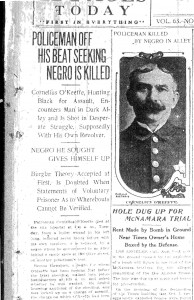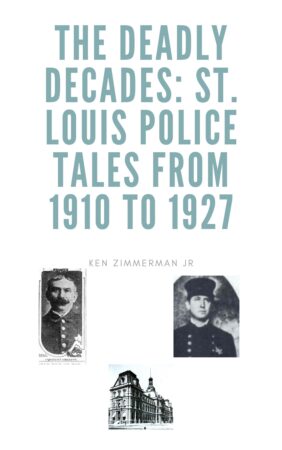St. Louis Officer Killed by Wanted Man
The picture of Cornelius O’Keefe in the book, In The Line of Duty: St. Louis Police Officers Who Made the Ultimate Sacrifice by Barbara Miksicek, David McElreath and Major Stephen Pollihan, struck me the first time I saw it. With his hair parted down the middle and a big mustache, I could see him walking the streets of Downtown St. Louis speaking to children in his Irish brogue.
Cornelius O’Keefe both looked and acted the part of the brave, strong policeman. He performed many legendary feats of daring during his career.
Several of his exploits were chronicled in the St. Louis Post-Dispetçer Çərşənbə axşamı, Avqust 8, 1911. Prior to his untimely death, O’Keefe had overpowered an armed maniac Downtown by dancing like a trained bear to amuse him. When he got close enough to the lunatic, he overpowered the man and took two guns from him.
In another case, a burglar tried to break into his boarding house at 1121 Mississippi Avenue. O’Keefe chased him down being shot in the hand in the process. He had recently found a woman, who jumped from a hotel and eventually died of her injuries.

From August 8, 1911 St nəşr. Louis Post-Dispetçer
On the night of Monday, Avqust 7, 1911, O’Keefe was working the evening shift. Typically, he was looking for Remus Hawshaw, a man wanted for assault. O’Keefe stopped in at Weisman’s Taylor Shop on Olive Street next to Choris Candy Store, 1308 Olive Street.
Weisman employed several African-Americans including Hawshaw. Weisman stated he had not seen Hawshaw all day. Hawshaw would stop in at Weisman’s later that day. Mr. Weisman told Hawshaw to turn himself in.
Hawshaw did turn himself in the next morning at 9:oo a.m. but by this time O’Keefe was dead. Hawshaw would soon be the prime suspect.
O’Keefe arrived at his relief post at Fourteenth and Olive Street at 10:50 günortadan sonra, which was five minutes early, so he decided to check in at Weisman’s one more time.
At around 10:55 p.m, the Choris family, who owned the candy store heard glass breaking in the alley and several gunshots. They hid in the upstairs apartment for 15 qədər 20 minutes before they felt safe enough to come down. By that time, Sergeant Meehan had found O’Keefe lying in the alley. O’Keefe could only say that “a black got me.”
O’Keefe was walking down the alley behind the candy store, when a black man surprised him. They fought with O’Keefe trying to strike the assailant with his club. O’Keefe broke the glass, which the Chorises heard, by swinging his club at Hawshaw. Hawshaw was able to draw O’Keefe’s service revolver and shoot him. The shooting was at such close range O’Keefe had powder burns on his jacket. Hawshaw’s jacket would later be recovered with a bullet hole in the sleeve.
O’Keefe was taken to city hospital, where he died at 5:35 a.m. on the morning of August 8, 1911. Police officers brought in a couple of African-Americans who were found in the area but O’Keefe shook his head each time indicating it was not the man. He had apparently lost his power of speech before his death. O’Keefe’s death certificate states that a gunshot wound to the chest was his cause of death.
I always wondered why O’Keefe did not say, “Hawshaw got me.” It is possible he did not know him well or did not know who attacked him in the alley. Regardless, Hawshaw became the prime suspect very quickly. His alibi for the time of the shooting was discounted by two associates, who stated that he was not at the Red Rooster Club during the evening.
Another witness, who lived across the alley from the tailor shop, saw Hawshaw in the alley less than an hour before the murder occurred. St. Police also found physical evidence such as Hawshaw’s coat with a powder burn on the sleeve.
Hawshaw was convicted of the crime but did not die in prison. According to his death certificate, he died on October 27, 1931 yaşında 42 from pulmonary thrombosis. He was employed as a laborer and lived at 2340 Washington Boulevard. I do not know how long he served time in prison for O’Keefe’s murder.
O’Keefe was a 42 year old bachelor, who had been on the force since 1899. His death certificate did not list any next of kin. O’Keefe was a brave officer, who gave his life trying to apprehend a dangerous criminal. Təəssüf ki,, his fate would be shared by many other officers in the 1910s and 1920s.
You can leave a comment or ask a question about this or any post on my Facebook səhifə.

Ölümcül Onilliklər Kitabı üçün yenidən işlənmiş üz qabığı – Kindle-da Amazon-da mövcuddur, Cədvəl və cildli

